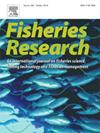Varying organic content in fish otoliths: Effects on SIMS-based δ18O measurements and possible corrections
IF 2.2
2区 农林科学
Q2 FISHERIES
引用次数: 0
Abstract
Varying organic contents in otoliths have complex and sometimes counterintuitive effects on intra-otolith δ18O measurements. This is often addressed by roasting otoliths or applying fixed corrections, however, the underlying chemical and physiological mechanisms involved are poorly understood and have not been tested in a quantitative manner, potentially rendering such corrections unreliable. Using high-resolution secondary ion mass spectrometry (SIMS) measurements of δ18O values paired with OH/16O ion ratios as organic proxy, we derived quantitative relationships of these measurements over the entire life of a large sample of northern pike (Esox lucius) otoliths from freshwater and brackish habitats. We assessed OH/16O ion count ratio as an organic tracer, and estimated its relationship with δ18O determinations. We developed a pointwise correction approach that accounted for variations in otolith organic contents. OH/16O ion ratio profiles agreed with other organic proxies, confirming them as reliable tracer of organic content. We detected an inverse relationship between δ18O values and OH/16O ion ratio, with elevated OH/16O ion ratios near otolith cores. OH/16O ratios decreased with distance to the core. Pairwise corrections for the effect of OH/16O ratios on δ18O values resulted in a mean offset between uncorrected and corrected values of 0.52 ‰, suggesting an approximately 2°C bias towards warmer temperature if uncorrected data were to be used for δ18O thermometry. Simultaneous determination on organic- and inorganic-bound oxygen resulted in a negative offset of δ18O, which varies with the life history of individual fish. Varying offsets in δ18O values within individual life histories could be accounted for using our correction. We recommend future SIMS-based δ18O thermometry studies to estimate the local organic content to assess whether correction is warranted. We further offer more general recommendations on how future studies may assess whether corrections for organics are necessary.

求助全文
约1分钟内获得全文
求助全文
来源期刊

Fisheries Research
农林科学-渔业
CiteScore
4.50
自引率
16.70%
发文量
294
审稿时长
15 weeks
期刊介绍:
This journal provides an international forum for the publication of papers in the areas of fisheries science, fishing technology, fisheries management and relevant socio-economics. The scope covers fisheries in salt, brackish and freshwater systems, and all aspects of associated ecology, environmental aspects of fisheries, and economics. Both theoretical and practical papers are acceptable, including laboratory and field experimental studies relevant to fisheries. Papers on the conservation of exploitable living resources are welcome. Review and Viewpoint articles are also published. As the specified areas inevitably impinge on and interrelate with each other, the approach of the journal is multidisciplinary, and authors are encouraged to emphasise the relevance of their own work to that of other disciplines. The journal is intended for fisheries scientists, biological oceanographers, gear technologists, economists, managers, administrators, policy makers and legislators.
 求助内容:
求助内容: 应助结果提醒方式:
应助结果提醒方式:


